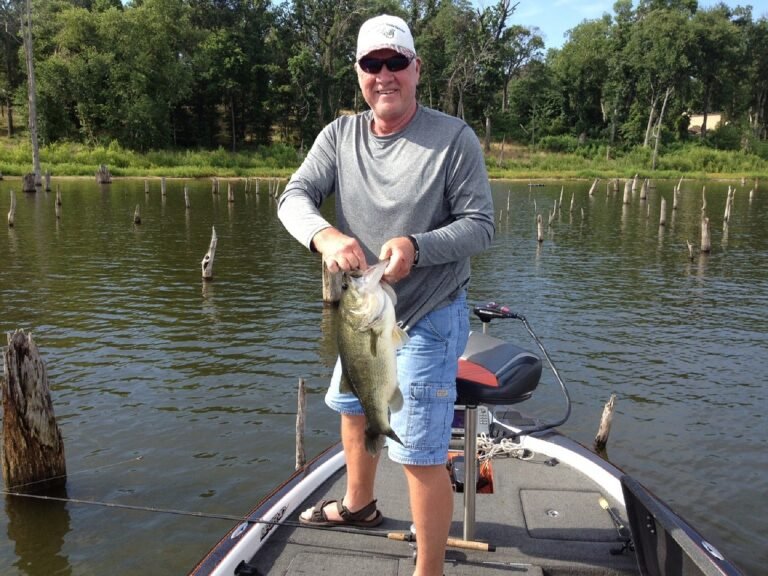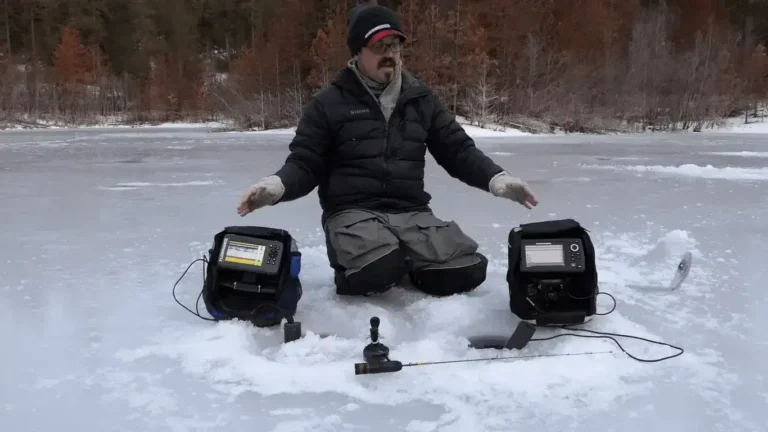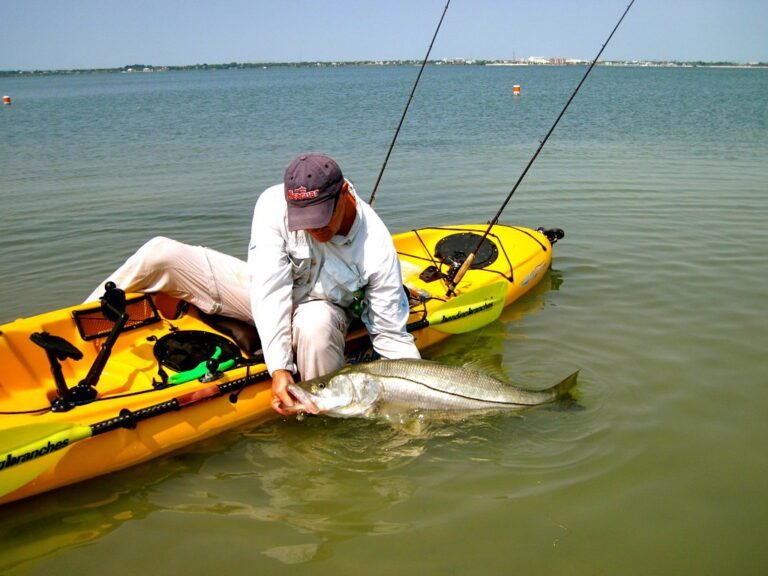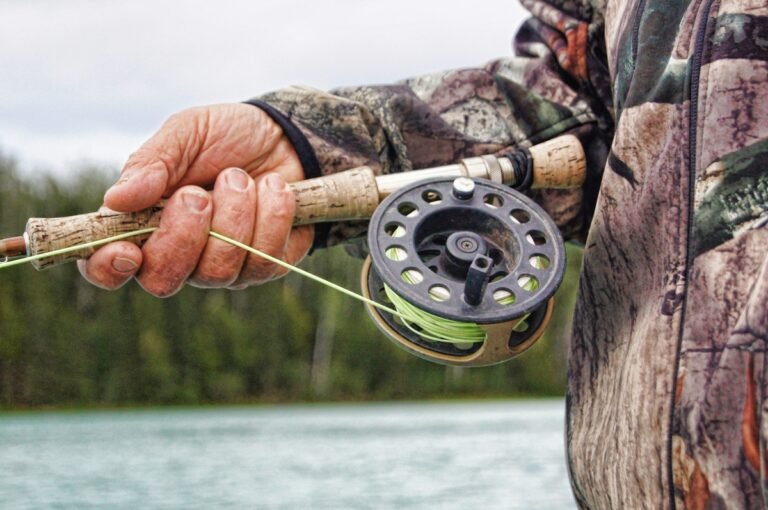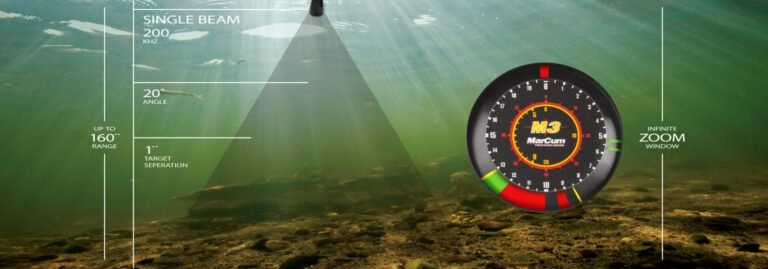Ice fishing is a favorite winter activity that involves grabbing fish through holes drilled in freezing bodies of water. It can be a positive and exciting way to enjoy the cold winter months, but it demands specialized gear to stay safe and cozy while on the ice. However, with the right equipment and a bit of knowledge, anyone can enjoy the sport of ice fishing.
This guide will provide a summary of the essential ice fishing gear for beginners, including rods, reels, lures, and more. With the correct gear, you’ll be prepared to start your ice fishing journey and hopefully land a big one!
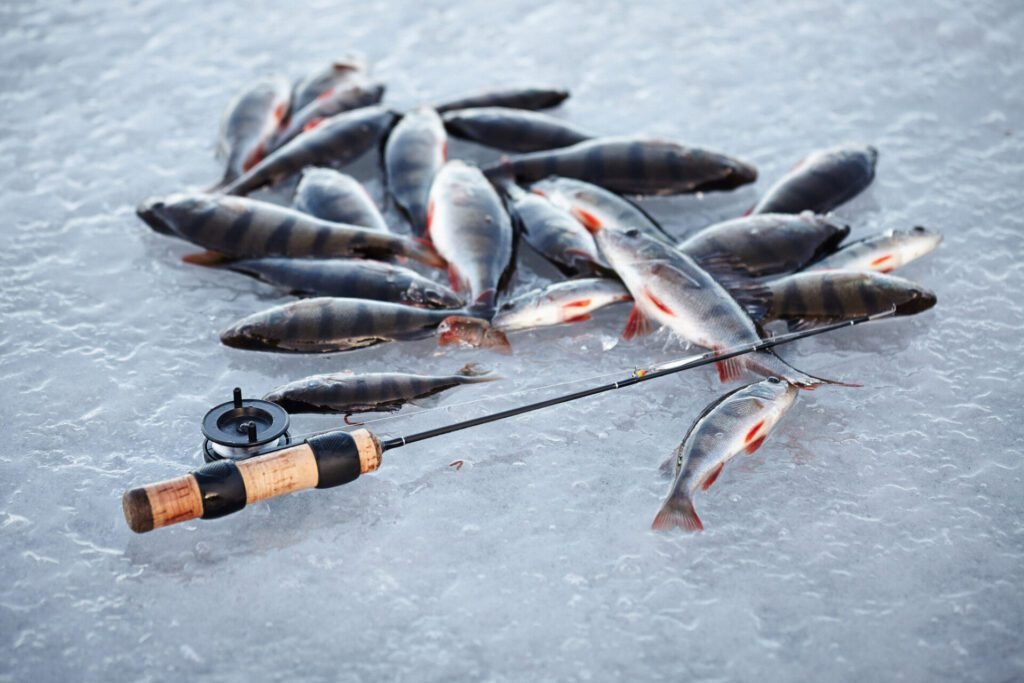
List Of Ice Fishing Gear For Beginners In 2024
Here is a list of ice fishing gear for beginners:
Clothing
It’s important to be properly dressed in order to remain warm and safe. Here are some essential considerations for selecting clothing to wear while ice fishing:
Headwear
A warm hat is important to keep your head and ears warm when ice fishing. Look for a nicely insulated and windproof hat, and consider adding a face mask or balaclava to protect your face from wind and cold.
Footwear
Your feet are especially susceptible to cold, so it’s necessary to have the right pair of boots with insulation and waterproofing. Look for boots with suitable insulation and a thermal rating, such as those rated to -40 degrees Fahrenheit. Additionally, it’s nice to bring an extra pair of socks to change into in case your feet get wet.
When choosing ice fishing boots, it is vital to consider the specific features that nicely suit your needs. To make an informed decision, we suggest looking at our article on the 5 Best Ice Fishing Boots, which provides in-depth reviews of some of the top available options.
Gloves and Hand Warmers
Having warm hands while ice fishing is necessary. Look for gloves that are nicely insulated, windproof, and waterproof. In addition, it’s a good idea to get along some hand warmers to put inside your gloves to assist in keeping your hands warm.
By these guidelines, you can ensure that you’re dressed correctly for an ice fishing journey and able to enjoy the adventure without worrying about being cold or uncomfortable.
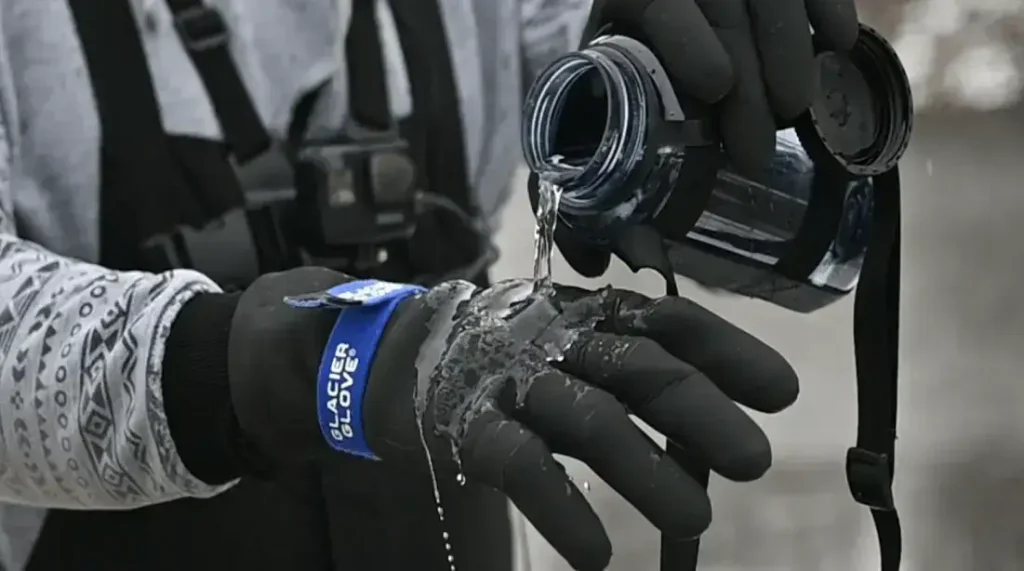
Ice Fishing Rods
Ice fishing rods are specialized fishing rods created for use via the ice on frozen lakes and rivers. They are normally shorter and more sensitive than standard fishing rods, making them well-suited for catching the light bites of fish that are common when fishing through the ice. Ice fishing rods are generally made from lightweight materials such as graphite or fiberglass, which allow for reducing fatigue while fishing. Many ice fishing rods also feature cork or foam handles, which provide a comfy grip even in freezing weather.
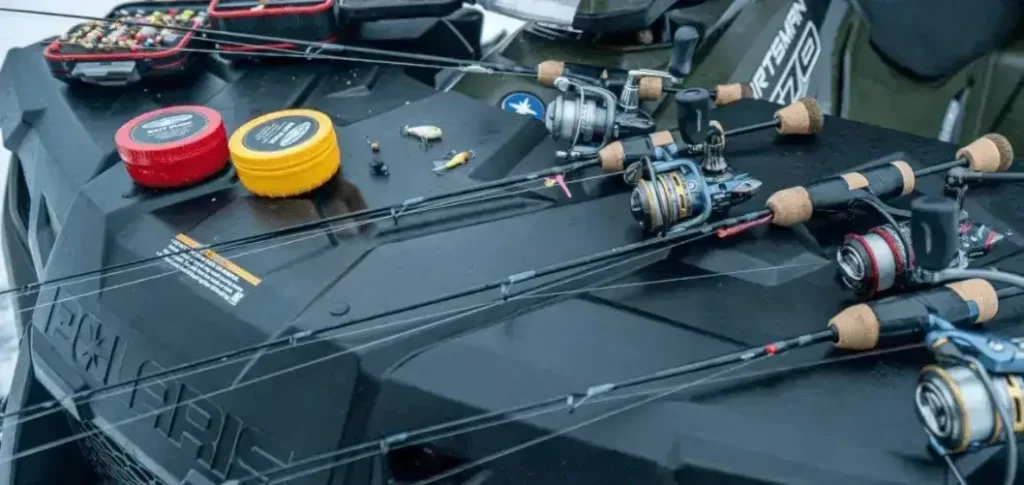
In terms of length, ice fishing rods normally range from 24 inches to 36 inches, with the most typical length being 28 inches. This length allows easy handling and casting while delivering enough power to reel a fish.
The rod’s action is also important and can be fast or moderate. It relies on the fish you are trying to catch. A fast-action rod will be more sensitive to bites, so the angler can quickly notice a fish nibbling on the bait. It is good for panfish and other short species. A moderate action rod will have more power, good for bigger fish like pike or lake trout.
Ice fishing rods also typically have a very low power rating, allowing anglers to use small baits and lures to catch fish through the ice. A light power rating also permits a more realistic representation of the bait, creating it more attractive to fish.
Ice Fishing Reels
Ice fishing reels are a vital component of ice fishing gear for beginners. These specialized reels work with ice fishing rods to make detecting and reeling fish via the ice as comfortable as possible. Ice fishing reels are generally smaller and more compact than standard fishing reels, as they are created to be used with shorter ice fishing rods. They also usually have a shorter line capacity, as the fishing is done in relatively shallow waters.
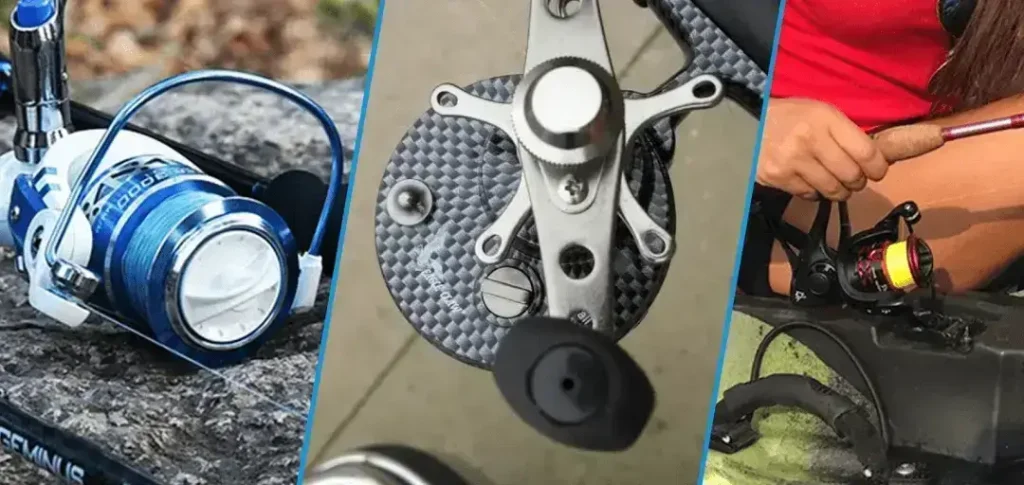
The spinning reel is the most typical type of ice fishing, known for its ease of use, versatility, and ability to control light to medium fishing lines. They are also favored due to their smooth drag system, which lets anglers reel in fish easily. Another type of reel used in ice fishing is the spin cast reel, it’s equal to the spinning reel, but the line comes out from a button on top of the reel. This reel is also easy to use, and the line is covered inside the reel, which assists in avoiding tangles and keeping the line clean.
Some ice fishing reels also feature a built-in line counter, which allows anglers to keep track of how many lines they have out and to change their depth accordingly. They are prepared to withstand the frigid temperatures and moisture faced while ice fishing, and many are constructed from lightweight and long-lasting materials such as aluminum or graphite.
Ice Fishing Line
Ice fishing line is an essential aspect of ice fishing gear for beginners. It is the connection between the angler and the fish and is a key factor in deciding the success of an ice fishing trip. It is generally made from monofilament or fluorocarbon material, which is appropriate for fishing in cold water.
Monofilament lines have good elasticity and knot strength and are a suitable option for panfish or other small species Fluorocarbon lines, on the other hand, are more sensitive, invisible underwater and have a higher knot and abrasion resistance. It’s ideal for larger fish or when stealth is important.
When choosing an ice fishing line, it’s important to consider the size and species of fish you will target and the water conditions. A lighter line is typically preferred for ice fishing as it permits a more realistic presentation of the bait and makes it harder for fish to detect. Ice fishing lines are obtainable in various breaking strengths measured in pounds (lbs). The breaking strength shows how much weight the line can carry before breaking. As a beginner, it’s recommended to use a line with a breaking strength of 2-4 lbs for panfish and 6-8 lbs for bigger species.
Another significant factor to consider when selecting an ice fishing line is its diameter or “test.” This measurement tells how thick the line is, thinner lines have a higher sensitivity but less strength and thicker lines have more strength but are less sensitive. In addition, ice fishing lines also come in various colors, such as transparent, low-vis green, blue, or even hi-vis orange. It can be helpful when fishing in different light conditions.
Ice Fishing Augers
An auger is a must-have part of equipment when it comes to ice fishing. It’s the tool used to dig holes in the ice, and without one, you won’t be able to fish. There are three main types of augers: manual, gas, and power.
Manual augers are the most economical and easiest to use, but they can be tiring for extended periods. Gas-powered augers are more strong but can be heavy and emit exhaust fumes. Electric augers are light and convenient, but they need a power source.
When it comes to ice fishing gear for beginners, manual augers are often the most recommended as they are easy to use and can be very affordable. They can be powered using a hand crank or leverage a drill with an auger bit attachment. Furthermore, manual augers are relatively lightweight, making them easy to transport to and from the fishing spot.
Ice Fishing Jigs And Baits
Ice fishing jigs and baits are an essential part of ice fishing gear for beginners. Jigs are small, weighty lures that are created to mimic the movement of tiny fish or insects. They are normally made of a lead or tungsten head with a hook connected and a feather or plastic tail. On the other hand, Baits are natural or artificial substances that attract fish to the hook.
Ice fishing jigs come in different shapes, sizes, and colors and can be fished vertically, horizontally, or with a jigging motion. Some popular ice-fishing jigs for newbies include tungsten jigs, jigging spoons, and bucktail jigs. These short and lightweight jigs make them easy to cast and retrieve via the small holes drilled in the ice.
When it comes to baits, maggots, waxworms, and spikes are common and useful options for ice fishing. They are small, effortless to find, and can be used to grab panfish, perch, and crappie. Some beginners may like using artificial bait like soft plastic lures or grubs, which can also be useful in catching fish.
Ice Fishing Shelters
A portable ice fishing shelter is an important part of ice fishing gear for beginners. These shelters provide a warm and dry atmosphere for anglers to fish, saving them from harsh winter weather conditions.
Several types of portable ice fishing shelters are known on the market, including pop-up shelters, flip-over shelters, and hub shelters. Pop-up shelters are effortless to set up and take down and provide plenty of space for one or two anglers. Flip-over shelters are parallel to pop-up shelters, but they have a hinged top that can be flipped over the fishing hole, providing easy access to the hole. Hub shelters are the most famous and practical option. They are easy to set up and take down, offer a lot of areas, and come in various sizes.
When it comes to ice fishing gear for beginners, portable ice fishing shelters are an important consideration, as they provide a comfortable and warm climate to fish. Many of them are also light, easy to transport, and set up, making them a convenient option for anglers. It is also necessary to note that some portable shelters come with built-in insulation, which can aid in keeping the shelter warm and comfortable.
Ice Fishing Skimmer
An ice fishing skimmer is a handy piece of gear often used by ice anglers to clear slush and debris from the surface of the ice fishing hole. It is a scoop-like tool with a long handle that keeps the hole neat and clear, making it easier to fish.
Ice fishing skimmers come in different shapes and sizes, some created for small holes and others for larger ones. They can be constructed from plastic, metal, or a mixture of both materials. Some skimmers have a built-in strainer, allowing for easy fish removal from the hole.
When it comes to ice fishing gear for beginners, an ice fishing skimmer is a valuable tool to have. It is an affordable and easy way to clear the hole, making fishing more effortless. It is also a protection tool for the angler, as it allows them to remove any slush or waste from the hole that might pose a risk of slipping or falling via the ice.
Ice Fishing Tip-ups
A tip-up is a favored piece of ice fishing gear, especially among newbies, as it lets anglers fish multiple holes at one time or set a hook while they move around the fishing spot. It is an easy device consisting of a spool of line, a flag, and a trip mechanism, which activates the flag to pop up when a fish is biting, alerting the angler to the catch.
When it comes to ice fishing gear for beginners, tip-ups are a great choice because they are relatively straightforward to use and can be an efficient way to catch fish. They can target different species of fish, such as pike, walleye, and even big trout, depending on the size of the line and the bait used. They are also useful when fishing in deeper waters or when you want to hold the bait at a specific depth.
When using tip-ups, it is necessary to check them repeatedly, as a fish biting on the bait could take some time to set the hook, and the flag may pop up sometime after the bite occurs. Setting the trip mechanism accurately and knowing how to read the flag is also essential to know when a fish is on the line and avoiding missed bites.
Ice Fishing Electronics
Ice fishing electronics can help anglers locate fish underneath the ice. These devices can contain fish finders, underwater cameras, and flashers, which can help anglers identify the fish’s location, the water’s depth, and the lake floor’s structure.
Fish finders are one of the most famous types of ice fishing electronics and are used to find fish by emitting a sonar signal and reading the reflection of that signal off of objects in the water. Fish finders can show the depth, fish location and even size, water temperature, and clarity. One of the best techniques to improve your chances of catching fish is using a high-quality fish finder. With features such as high-resolution displays, advanced sonar technology, and GPS capabilities, these fish finders will help you efficiently locate fish. So be sure to check out our list of the 5 best fish finders to up your ice fishing game.
Underwater cameras, another widespread ice fishing electronics, allow anglers to see what’s happening underneath the ice in real-time. You can use them to check on the bait and see if fish are biting or to observe the fish’s behavior. It can be useful when trying to decide the best type of bait or jig to use.
Flashers, also called sonar flashers or fish flashers, are ice-fishing electronics that use a mixture of sonar and a visual display to assist the angler in detecting fish. They show the location of fish with a series of lights or colors. Flashers are normally used to locate fish quickly by anglers targeting schools of fish, as well as to aid in the separation of species. One key element to getting the most out of your flasher is to know how to properly adjust it’s settings. Check out this guide on how to use a flasher.
These electronics can seem overwhelming when it comes to ice fishing gear for beginners, but they don’t have to be. Some newbies prefer starting with basic gear, such as a simple depth finder, and working their way up to more advanced electronics. The key is to choose the user-friendly and effortless electronic understand and learn how to use it properly.
Overall, these essentials will assist you in having a safe and prosperous ice fishing experience. Remember to permanently check the ice conditions before heading out, and never fish alone. With these tools and tolerance, you can grab fish on the ice and enjoy a winter sport.
How Thick Should Ice Be For Ice Fishing?
The thickness of ice for safe ice fishing can vary depending on several factors, including the type of body of water, the temperature, and the prerequisites of the ice itself. However, as a general rule of thumb, ice should be at least 4 inches thick to support an individual’s weight.
It is necessary to remember that ice is never 100% safe, and it is suggested to check the ice conditions frequently, especially after a warm spell or during the thawing of ice.
Also, you should be aware that various bodies of water may have different recommended minimum ice thicknesses. For instance, 8 inches of clear ice on a large lake may be considered safe, while 6 inches on a small pond may be safe.
It is also necessary to remember that ice thickness can vary rapidly change due to temperature or water level changes. Even if the ice seems thick and solid, it is still important to be careful and use proper safety gear when fishing.
What Is An Ice Fishing Rig?
An ice fishing rig is a mixture of bait, hooks, and other terminal tackle utilized to catch fish via the ice. It contains a fishing line, hook or jig, and weight or bobber to keep the bait or lure at a precise depth. Different designs are used for various species and techniques. For example, some mimic the movement of live bait, while others imitate tiny aquatic animals or insects. It’s important to consider the species and conditions of the ice and comply with local rules while setting up the rig.
FAQs:
how much does ice fishing gear cost?
Ice fishing gear can vary widely in cost, with basic setups starting around $50 and deluxe packages including high-end gear and accessories costing several hundred dollars. It usually depends on the type of fishing, place, and personal preferences.
can you use worms for ice fishing?
Yes, worms can be great bait for ice fishing. They are a natural food source for many fish and can effectively attract a wide variety of species.
Conclusion:
In conclusion, ice fishing gear for beginners contains essential items such as a fishing rod and reel, bait, an auger to create holes in the ice, and a skimmer or scoop to clear slush and debris from the holes. Other items such as a portable shelter, insulated clothing, and a fish finder can also improve the ice fishing experience for beginners.

